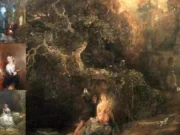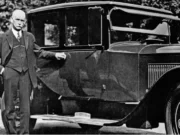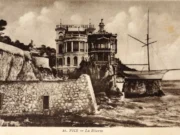Wyatt Earp stands in silent reverence beside a 1926 Packard Model 326 “Opera Coupe,” a vehicle whispered to have once belonged to the legendary silent film icon, William S. Hart. Unlike Hart’s contemporary, Tom Mix, who flaunted his wealth with flamboyant automobiles, Hart’s taste was marked by a restrained elegance.
While Mix, earning a lavish $7,500 weekly at Fox with minimal tax burden, indulged in luxurious outings, Earp’s association with Hart reflected a different kind of camaraderie—one steeped in authenticity and shared history.
1926 Packard “Opera Coupe”: Wyatt Earp & William S. Hart
In the golden era of silent cinema, Earp, residing in Los Angeles, found himself drawn to the burgeoning film industry. Though he remained unpaid, his role as a consultant on silent cowboy films allowed him to impart his wealth of knowledge about the Old West.
One notable instance was in 1915 when Earp visited the set of “The Half-Breed,” directed by Allan Dwan and starring Douglas Fairbanks. Dwan later recalled how Earp, as was customary, was invited to blend into the background action, lending an air of genuine Western authenticity to the scenes.
Read More – Le Plongeoir Restaurant – Early 1900s Charm in Nice, France
Wyatt Earp’s connections within the film industry deepened, leading to friendships with Hart and Mix, the era’s most renowned cowboy actors. William S. Hart, a meticulous advocate for realism in his Western portrayals, likely sought Earp’s counsel to ensure the accuracy of his films. Their bond was more than just professional; it was a melding of two worlds—the cinematic and the historical—each influencing the other.
Determined to set the record straight about his life, Earp implored Hart to bring his story to the silver screen. In a letter, Earp expressed his desire to correct the public’s misconceptions, writing, “If the narrative were brought to life on the screen by you, it would greatly aid in rectifying the falsehoods that have long been perpetuated about me.”
























